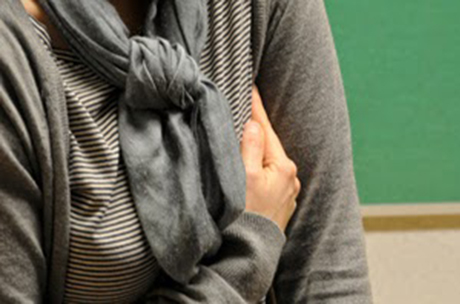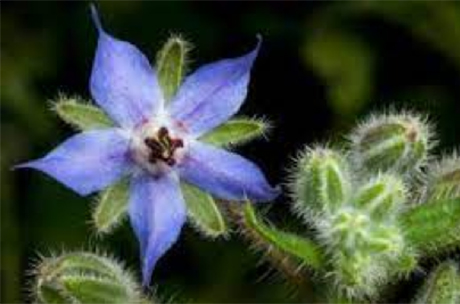
Most women have breast discomfort at some stage. Often pain develops in the days just before a period. Pain is generally mild, but it can be severe, affecting quality of life, physical activity, lying on your side/front. Hugging and sexual activity can be uncomfortable.
Evening Primrose/Starflower Oil could be worth trying.
What are the types of breast pain?
Breast pain (also known as Mastalgia) is classified as either hormonal or nonhormonal:
- Hormonal breast pain - where the pain is related to periods and tends to get worse in the days just before a period. It can also be triggered by contraception and HRT use.
- Non-Hormonal breast pain - where the pain is not related to hormones.
This self-help leaflet is for hormone related breast pain. Up to 7 in 10 women develop breast pain at some stage in their life. About 2 in 3 cases are caused by hormones.
Hormonal breast pain
Hormonal breast pain is very common. It can occur at any age after periods start, but most commonly first develops between the ages of 30 and 50 years. It does not occur in women past the menopause when periods have stopped (unless they are taking HRT).
In many women the symptoms are mild. Indeed, it can be considered normal to have some breast discomfort for a few days before a period. However, in around 1 in 10 women the pain can be severe and/or last longer - up to 1-2 weeks before a period.
The 3-5 days prior to a period are usually the worst. The pain usually eases soon after a period starts and the severity can vary month to month. Usually, the pain affects both breasts. Breasts may also feel more swollen and lumpier than usual – and then improve soon after the period starts.
What causes this sort of breast pain?
It is thought that women with hormonal breast pain have breast tissue which is more sensitive than usual to the normal hormonal changes that occur each month. It is not due to any hormone disease or to any problem in the breast itself. It is not related to any other breast conditions. Although it is not serious, it can be a nuisance. Hormones in contraception and HRT can cause slight fluid retention which can also cause breast discomfort.
What are the self-help treatment options for hormonal breast pain?
No treatment may be needed if the symptoms are mild.
Many women are reassured by knowing that hormonal breast pain is not a symptom of cancer or serious breast disease.
The problem may settle by itself. Studies have shown that hormonal breast pain goes away within three months of onset in about 3 in 10 cases.
However, in up to 6 in 10 women where the pain has gone, it develops again sometime within two years. So, hormonal breast pain may come and go over the years.
The contraceptive pill or hormone replacement therapy (HRT) may make hormonal breast pain worse – sometimes a change in product will help.
Other drugs may worsen breast pain. For example, some anti-depressants and some blood pressure drugs. If appropriate, it may be worth discussing this with your Healthcare professional.
If the pain is more severe, or for the times when it may flare up worse than usual, treatment options include the following:
- Support your breasts. Wear a well supporting bra when you have pain. It may be worthwhile having a bra fitted for you as many women actually wear the wrong size. Some women find that wearing a supporting bra 24 hours a day for the week before a period is helpful. It is best to avoid underwired bras. Wear a sports bra during exercise.
- Painkillers such as paracetamol, codeine, or tramadol. Take regularly on the days when the breasts are painful. Ibuprofen and diclofenac gel can be applied directly to the breast tissue.
A trial of either Starflower Oil or evening Primrose Oil.
These are both rich in a substance called GLA (Gamma Linoleic Acid), which has been found to sometimes help with breast pain. It is poorly understood why this may help and some studies have cast doubt on whether it helps or not. However, many women do seem to get benefit from trying it, and it is a simple treatment with few side effects. It can be worth trying.
Starflower Oil and Evening Primrose aren’t available on prescription. However, they are not expensive and can be bought over the counter. It is important to take an adequate dose of GLA - It is thought that a daily dose should be 240-320mg.
 The ingredients list on the pack should say how much GLA there is in each capsule - Starflower oil capsules generally contain more GLA than Evening Primrose Oil.
The ingredients list on the pack should say how much GLA there is in each capsule - Starflower oil capsules generally contain more GLA than Evening Primrose Oil.
You may need to take several capsules daily. You need to take the capsules for at least a few months to see if it helps. If there is no improvement by 4 months, it’s not likely to help.
Some capsules have added vitamins. If you need to take several capsules daily there is the possibility of taking more than the daily recommended dose of a vitamin. Sometimes this doesn’t matter but some vitamins can be harmful if too much is taken. So, it’s best to take capsules that do not include added vitamins.
GLA has been associated with miscarriage, so please do not use this treatment if you are hoping to conceive. Side effects are rare. However:
• Some people do experience nausea with GLA.
• Women with epilepsy are generally advised to not take GLA (although the evidence for any problem is of uncertain quality).
• GLA can sometimes increase the tendency to bleed, so if you are taking any blood thinning tablets (such as warfarin), or have a problem with easy bleeding, you should discuss this with your Healthcare professional before taking GLA.
•There are a few interactions with some other drugs, so please check with your Healthcare professional if you are unsure.
Non-Hormonal Breast Pain
Breast pain can be present all the time or come and go in a random way. This type of breast pain is not related to periods and is most common in women aged over 40. The pain may be in just one breast and may be localised to one area of the breast. Sometimes the pain is felt all over one or both breasts. Please see a healthcare professional for further advice.
Breast tumours, cancer and lumps are a very uncommon cause of breast pain, however, please seek medical advice if you have any of the following:
- A lump in your breast or under your axilla (armpits)
- Discharge from a lump or nipple (this may be blood-stained)
- A family history of breast cancer
- Swelling and/or redness in your breast
